A quick-glance at the main requirements
General guidance
- Use nutritionLESS soil, e.g. peat moss and/or live sphagnum moss + aeration additives such as quartz sand or perlite (well rinsed wwith rainwater)
- Soil needs to be moistened first
- Never water with tap water, only rainwater, distilled, or reverse osmosis water
- If you’re going to place the plants under the sun, do it gradually.
- VFTs require a dormancy period
- VFTs require as much sunlight as possible, either artificial or natural sunlight
For general information common for all Carnivorous Plants, including Flytraps, please first read the Carnivorous plants care guide (general information)
Feeding
Since your plants will live in nutrient-poor soil AND get pure water, they need nutrients from elsewhere. Normally, if your keep the plants outdoors year-round they will be able to catch bugs naturally. However, for indoor plants that’s not always the case, so you may need to supplement their diet a bit, here’s what you can use:
- Freeze-dried bloodworms – take some out in a little bowl, add a few drops of water, mix well. Pick a bit of the mixture, dry it on a piece of kitchen towel to remove as much as possible from the water and place it in one to two traps per plant, do not give to every trap, this poses a risk of overfeeding and killing your plant. Once you add the food in the trap, simulate as if it’s a living bug by gently pressing the trap between your fingers for 30 seconds. This will mimic a living insect still moving inside the trap, and the trap will seal. If you skip this step, the trap will re-open soon due to its natural mechanism of sealing only when there’s a living insect and not sealing in case a raindrop falls inside of it, preventing it from using too much energy. See the video here -> For baby traps and simulation of “living bug”, check THIS video.
In the photo below you will see a sealed trap. This means the digestion process has begun! This trap will stay closed for several days; normally about 5 days in warm conditions
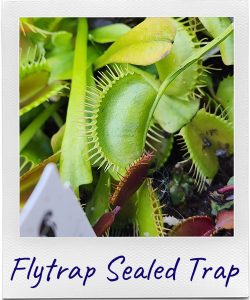
Sealed and Digesting Young Venus Flytrap
Light
Sunlight
Plants require a good amount of direct sunlight – 6-8 hours per day to grow healthy.
Introducing a plant to sunlight must happen gradually. Read this article for more info: How to Move a Plant From Artificial Light to Sun Light
Repotting
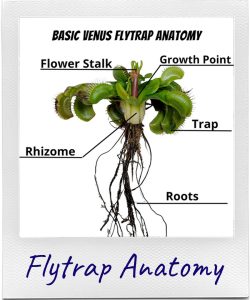
For general information on pot types, how to repot and what soil to use, see Carnivorous plants care guide (general information)
When and how to repot?
The best time to repot is during dormancy of the plant – this is the time the plant is least disturbed and likely to die if you damage some of its roots. To remove the old soil from the roots of the plants, rinse with distilled/rain/ro water. Venus Flytrap’s roots are black, so be very careful not to damage them when repotting. Of course, it can happen, as long as the plant has most of its roots there, it will be ok. When planting, make sure to put the rhizome in the soil up to the level where new growth emerges. See the picture below.
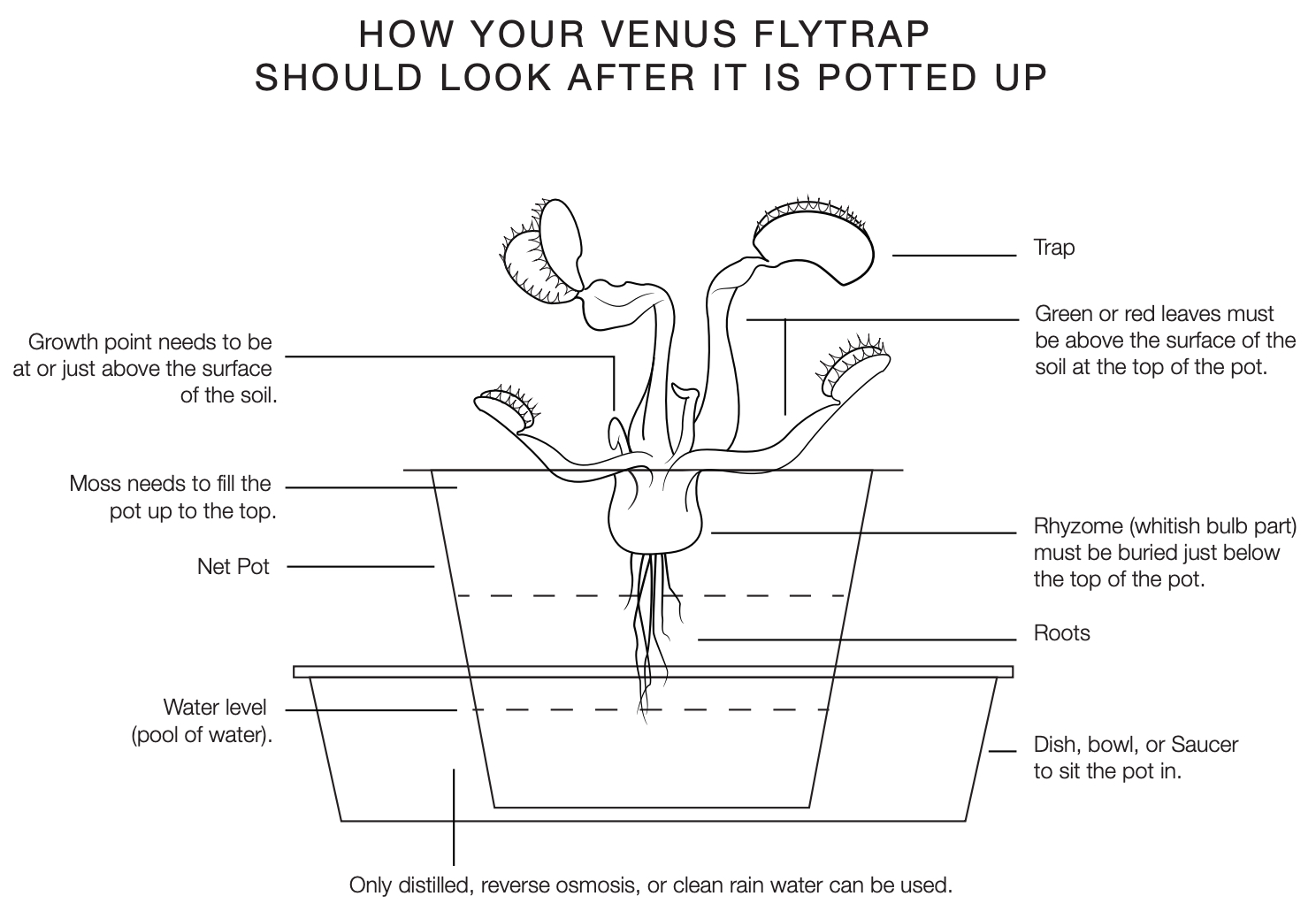
Dormancy
VFTs require dormancy if you want to keep them alive. If they do not go dormant for 2-3 years in a row, they will likely die. It’s a scary thing to do – letting them go dormant outside, but once you’ve done it, it gets easier.
Pollination
First, an anatomy lesson of VFT flowers
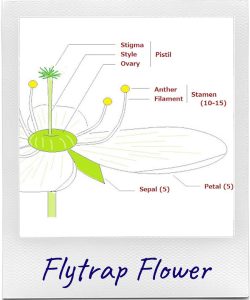
Letting your plant flower, means a lot of energy is put into its growth, which will/may make your plant die, especially if it is a young plant, so i’d suggest to leave one flower at most and cut the rest as soon as they start emerging and for young plants – trim all the flowers and let the plant use its energy to grow traps and roots instead.
One flower stalk will have multiple flowers on it, and they come up one after another, not at the same time. The same is valid for when they are ready to pollinate and when they die off. Once the flower has pollen on its anthers, collect some with the brush (the powder should be visible on the brush) and gently spread the pollen on the stigma of the same or another flower. Do that a few times: VIDEO. If it’s too early in the development of the flower, it may not have pollen yet, or if it’s too late, the stigma may be black. I’d still add pollen on the black stigma, but i don’t guarantee if it will work.
If the pollination was successful, you will see how the flower base starts growing bigger and bigger. You can most clearly see that by comparing a successful and an unsuccessful flower. So it takes some practice.
Seed harvesting
I’d cut the flowers one by one only when ready – ready means you can see the flower breaking the shield and exposing the seeds underneath it – see the photo below.
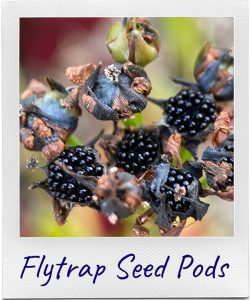
Q&A
Q: When to cut VFT flower stalk?
- A1: When they are 7 – 10 cm long
- A2: If I don’t want some Flytraps to produce seed, I often cut the flower stalks off shortly after they emerge, when they are under 1 inch (2.5 centimeters) tall.
- A3: Cut the stalk off when it is still small.
Q: Growing a VFT from a flower stalk?
- A1: They do take a far few months to start to show any signs of life,i just stick the cut end next to the mother plant about 10 mm into the soil and wait,i put them next to the mother plant so ID is easy,a great way to clone and success rate ain’t too bad either
- A2: Here’s two forum threads on the subject:
http://www.cpukforum.com/forum/index.php?showtopic=27604
http://www.cpukforum.com/forum/index.php?showtopic=20603